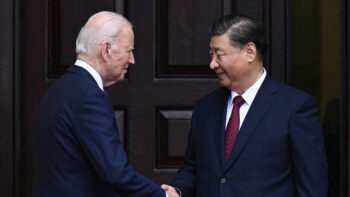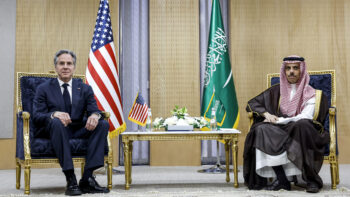 WASHINGTON: When the Presidential Daily Briefing occurs, a top intelligence official traditionally hands the president a folder with a sheaf of paper inside. The president may read what’s inside or have it presented by the intelligence official. Then comes question time, when the chief executive and commander in chief can ask how reliable a source is or question the assumptions of an analysis he’s just read.
WASHINGTON: When the Presidential Daily Briefing occurs, a top intelligence official traditionally hands the president a folder with a sheaf of paper inside. The president may read what’s inside or have it presented by the intelligence official. Then comes question time, when the chief executive and commander in chief can ask how reliable a source is or question the assumptions of an analysis he’s just read.
But that will change. The president and his top officials want and will get a single mobile device allowing them to access highly classified and unclassified data wherever they are. The early fruits of the intelligence community’s early efforts to do that are visible in the photo above. It shows President Obama in the Oval Office on January 31 using a technically neutered tablet as part of the Presidential Daily Briefing.
Instead of reading through the brief, now the president can scroll through the briefing and tap on a link in a story that takes him to background material, maps, photos, video or audio.
The White House Communications Agency, which actually does what its name indicates, needs to provide better services and devices because its customers, from the president on down, are demanding it. “Sending emails and making phone calls does not satisfy their information requirements. They want access to data,” Army Col. Clinton Bigger, commander of the White House Communications Agency said last week at a conference. Bigger’s agency created an innovation cell to study mobile pilot programs across government to get a clear idea of what is needed and what is available.
The intelligence community and White House began working on delivering information via tablet or smartphone to senior officials during the transition when President Obama was elected, according to a participant at a different event, this one hosted today by the Intelligence and National Security Alliance.
A single device is the Holy Grail for the intelligence community and senior government officials, but it will be some time before it happens, the colonel said. In the near term, the White House hopes to issue two devices: one for classified and another for unclassified communications. It is coordinating with the Defense Department and the National Security Agency to ensure access to secure defense communications networks intelligence grade cryptographic algorithms.
The broader goal is to develop a variant of a commercial smartphone or tablet that can access voice, video and data networks — what Bigger refers to as unified communications services. The devices must be able to operate outside of a secure government facility and allow users to be connected wherever they are. Currently, the tablets beings used to brief the president and other senior officials — including ambassadors — cannot access Wi-Fi and do not have cameras or GPS chips, a participant at the INSA event said. [Colin Clark was allowed to attend the event under the Chatham House Rule, which bars him from identifying any of the event’s participants.]
The intelligence community has already begun developing and delivering tablet apps for top intelligence users such as ambassadors and senior intelligence officials, according to someone at the INSA event. While the current tablets are neutered, Bigger and participants at the INSA event made clear that will change. This raises a host of complex and challenging issues for the intelligence community and its masters. If President Obama has access to a smartphone or tablet with a secure connection to intelligence databases isn’t he going to sometimes want access to information immediately? One of the participants foresaw a senior policymaker using chat or something similar to contact a top intelligence analyst, say someone covering Syria, and demanding information immediately.
“We are increasingly in the business of intelligence on demand,” said another participant. How it will reshape information management by both senior policymakers and intelligence officials is one of those things that will only be learned by doing. Two participants said they believed face-to-face briefings would remain a central part of the process. The president must trust the judgment and knowledge of his briefers if he is to feel comfortable pressing for more information and, let’s be be honest, rely on what he is being told.
It sounds as if the White House will certainly drive the requirements for any smartphone or tablet used by the president or his senior advisors. To that end, the White House Communication Agency’s innovation cell allows the White House to participate in any program across the government that meet its mission requirements, Bigger said. The results of these efforts are then sent to the Defense Information Systems Agency, which is responsible for setting and running DOD mobile and IT policy, and the NSA to keep these organizations filled in, he added.
One of the participants at the INSA event said that the intelligence community is largely relying on the Army’s work on smartphones and networks to serve them to develop architecture standards to guide them.
As part of that larger effort to distribute secure information, the White House is rolling its mobility efforts into DISA’s because the DoD agency has a well-defined mobility strategy and is creating an infrastructure for its personnel, Bigger said. Once that infrastructure is in place, the White House plans to use the Pentagon’s secure mobile infrastructure for its personnel. That doesn’t mean the White House will only use the military standards. The White House needs to retain its independent ability to communicate and share information across the entire government, he said.
Taking aim: Army leaders ponder mix of precision munitions vs conventional
Three four-star US Army generals this week weighed in with their opinions about finding the right balance between conventional and high-tech munitions – but the answers aren’t easy.


























